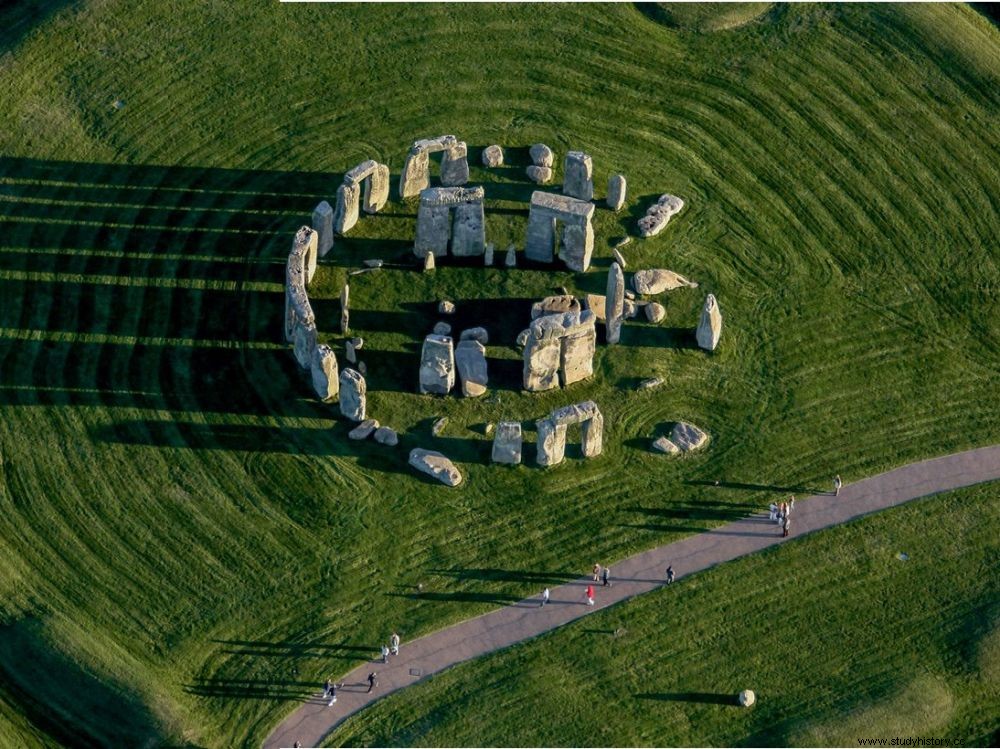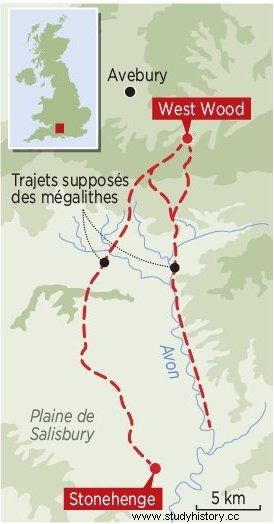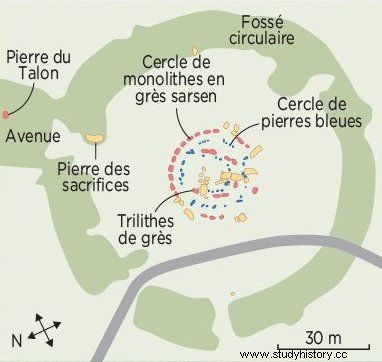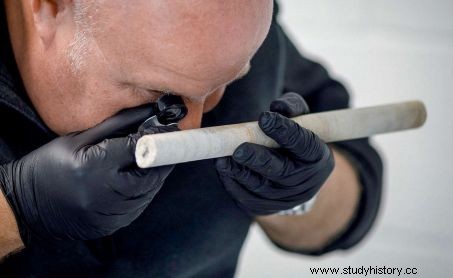Two studies shed new light on the origin of megaliths and the amazing acoustic properties of the British prehistoric monument.

The monument consists of several structures, concentric.
This article is taken from the monthly n°885 of Sciences et Avenir-La Recherche, on newsstands in November 2020.
These are the stories of men and women sought behind the stones of Stonehenge, Britain's iconic megalithic site considered the largest and most fascinating prehistoric structure in Europe. What did they want to express there? Studied for four centuries, these concentric walls, anchored in Salisbury Plain for 5000 years, have finally revealed one of their secrets, that of the origins of its most imposing megaliths. The researchers have in fact established that these upright blocks of stone, made of sarsen sandstone, a very hard rock, were taken from West Wood… 25 km north of the site. It was by studying the chemical composition of the blocks that David Nash, a geologist at the University of Brighton (Science Advances , July 2020), highlighted this correspondence. Above all, the researcher still cannot believe the circumstances that allowed him to make this discovery, thanks to the incredible adventure of a geological core.
The story begins in 1958, during a restoration program to straighten three of the Stonehenge monoliths. To do this, horizontal holes one meter long and 25 mm in diameter are drilled in the stone. However, one of these precious drill cores disappeared… only to reappear almost 60 years later on the other side of the Atlantic! The family of an American stonemason who intervened on the site discovered the sample one day among their belongings.
And immediately contacted English Heritage, the organization that manages Stonehenge, in order to return the precious carrot. "For us who had the obligation to use non-invasive methods to study these protected monoliths, this sample fell from the sky, rejoices today David Nash. English Heritage allowed us to grind a piece to dust for analysis. We compared the results with those obtained on sarsens samples from twenty different sites in Great Britain. That's how we were able to determine its provenance." Consider the site of West Wood, the closest to Stonehenge.

The sarsen stones were taken from West Wood, 25 km north of Stonehenge. Two routes were considered by the researchers for their transport:either by the River Avon, or further west, where the blocks could have been dragged or rolled using logs. (BRUNO BOURGEOIS)
Monuments used for more than a millennium
David Nash now hopes to find the exact location of the quarry from which the material was extracted in order to determine the route taken by Neolithic men and women to bring these stones.
This article is taken from the monthly n°885 of Sciences et Avenir-La Recherche, on newsstands in November 2020.
These are the stories of men and women sought behind the stones of Stonehenge, Britain's iconic megalithic site considered the largest and most fascinating prehistoric structure in Europe. What did they want to express there? Studied for four centuries, these concentric walls, anchored in Salisbury Plain for 5000 years, have finally revealed one of their secrets, that of the origins of its most imposing megaliths. The researchers have in fact established that these upright blocks of stone, made of sarsen sandstone, a very hard rock, were taken from West Wood… 25 km north of the site. It was by studying the chemical composition of the blocks that David Nash, a geologist at the University of Brighton (Science Advances , July 2020), highlighted this correspondence. Above all, the researcher still cannot believe the circumstances that allowed him to make this discovery, thanks to the incredible adventure of a geological core.
The story begins in 1958, during a restoration program to straighten three of Stonehenge's monoliths. To do this, horizontal holes one meter long and 25 mm in diameter are drilled in the stone. However, one of these precious drill cores disappeared… only to reappear almost 60 years later on the other side of the Atlantic! The family of an American stonemason who intervened on the site discovered the sample one day among their belongings.
And immediately contacted English Heritage, the organization that manages Stonehenge, in order to return the precious carrot. "For us who had the obligation to use non-invasive methods to study these protected monoliths, this sample fell from the sky, rejoices today David Nash. English Heritage allowed us to grind a piece to dust for analysis. We compared the results with those obtained on sarsens samples from twenty different sites in Great Britain. That's how we were able to determine its provenance." Consider the site of West Wood, the closest to Stonehenge.

The sarsen stones were taken from West Wood, 25 km north of Stonehenge. Two routes were considered by the researchers for their transport:either by the River Avon, or further west, where the blocks could have been dragged or rolled using logs. (BRUNO BOURGEOIS)
Monuments used for more than a millennium
David Nash now hopes to find the exact location of the quarry from which the material was extracted in order to determine the route taken by Neolithic men and women to transport these stones. Because the question always arouses passions and controversies:why was Stonehenge built, as were at the same period other megalithic monuments on all the western facade of Europe? Did the peoples of this period, learning about agriculture and domestication, see them as "temples" of stone? Still, these monuments have been in use for more than a millennium. The construction of the British site took place in several stages:during a first phase around 3,000 BC, a circular earthwork enclosure 90 meters in diameter was laid out, with 56 holes which were used -be at the implantation of wooden piles. Very quickly a double structure in the shape of a horseshoe is erected, made up of about 80 blue stones, the bluestones weighing an average of 2 tonnes, which come from the Preseli Hills in South West Wales about 260km from Stonehenge. Then, around 2500 BC, the great Stonehenge was built with a circle of 30 sarsen stones, some topped with lintels, the triliths. The flint-cut blocks are up to six meters high and weigh an average of 25 tons, some reaching 40. The upper lintels were fitted without masonry but with mortises and tenons demonstrating great craftsmanship.

The monument is made up of several concentric structures:one composed of 80 blue stones, the other of 30 blocks of sarsen, some arranged in trilithons. The Talon stone, placed outside the moat, could mark the direction of the rising sun. The Stone of Sacrifices was part of the portals that marked the entrance to the complex. The avenue leads to the River Avon, 3 km to the east. (BRUNO BOURGEOIS)
This titanic work testifies to the importance of the place for the population. The construction, burial mounds and tombs around the stones indicate strong power and an economy rich enough to sustain the time and effort required. For Mike Parker Pearson, a British archaeologist who has worked on the site and its surroundings since 2003, Stonehenge "was the largest cemetery in Britain, used from 3000 to 2300 BC. The first burials took place before the stones come" . The remains of more than 200 people who were cremated or buried were exhumed from the ditches surrounding the stones, sometimes accompanied by objects (daggers, axes, etc.). Excavations at Durrington Walls, another Neolithic enclosure 3 km away, reveal that Stonehenge was not isolated. The researchers discovered a village there also dating from 2500 BC:small houses containing many animal remains, 90% pigs, and cows. Did the builders of Stonehenge inhabit Durrington Walls? "Perhaps there were banquets held in this village before the procession left for Stonehenge, suggests Mike Pearson. We discovered a circle 2 km in diameter drawn by large pits in which wooden stakes were driven. They would mark the limits of a sacred area. One thing is certain:there were links between these different sites." Archaeologist Tim Darvill has his idea:Stonehenge would have been a sacred place where the sick came to seek healing because some skeletons bore traces of illness or injury.
A very precise chemical signature
David Nash, a geologist at the University of Brighton (United Kingdom), used a non-invasive method to study the composition of sarsens, these raised blocks of 25 tons. The stones were bombarded with high intensity X-rays which determined that they are composed of more than 99% silica and that 50 of the 52 megaliths share the same geochemical composition and therefore come from the same place. He was then able to compare the chemical signature of the megaliths with that of sarsens extracted from around twenty sites in the south of the island.

The core collected in the late 1950s, and found 60 years later in the United States, has allowed researchers to determine the provenance of the sarsen sandstone. (SAM FROST, ENGLISH HERITAGE)
Beyond the different interpretations, the astronomical role of the megaliths is not disputed. During the summer solstice, the first rays of the sun indeed cross the monument through the center, passing near the Heel Stone, an uncut sandstone, located outside the circle. Perhaps a landmark wanted by the builders to mark the direction of the rising sun. It is from this stone that the "avenue" begins which heads northeast and joins the River Avon. It looks like a processional way and could have been used to transport the bluestones from the river. "Stonehenge may have served different functions in different eras, summarizes Susan Greaney, historian at English Heritage. This prehistoric site is aligned with the movements of the sun. The latest studies show that large gatherings tend to take place at the winter solstice. Nothing was found inside the stone circle, everything was cleared at the time. We don't have clues about beliefs." Hence the ample room left to everyone's imagination to interpret Stonehenge.
Amazing acoustics
The site had amazing acoustic properties, as demonstrated by a recent study. Trevor Cox, acoustician from the University of Salford (United Kingdom) and his team* chose the layout of the megaliths corresponding to 2200 BC, Stonehenge having changed plan according to the times. They also assumed that they formed a complete circle with 157 standing stones. Using data obtained by laser scanning and 3D printing, they reconstructed the site in the form of a 1/12 scale model. The researchers then installed microphones and speakers and emitted sounds at different frequencies. Result:these are amplified by 10 to 20% inside with a rendering identical to that of a concert hall… even though the site is outdoors! On the other hand, these sounds are barely perceptible from the outside. What was happening inside the circle was therefore not audible to a large audience outside... And the mystery is further increased.
* Journal of Archaeological Science , August 2020.
